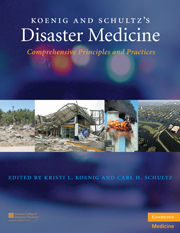Book contents
- Frontmatter
- Contents
- List of Contributors
- Contributor Biographies
- Foreword
- Preface
- Acknowledgments
- PART I CONCEPTUAL FRAMEWORK AND STRATEGIC OVERVIEW
- PART II OPERATIONAL ISSUES
- 9 Public Health and Emergency Management Systems
- 10 Legislative Authorities and Regulatory Issues
- 11 Syndromic Surveillance
- 12 Triage
- 13 Personal Protective Equipment
- 14 Decontamination
- 15 Quarantine
- 16 Mass Dispensing of Antibiotics and Vaccines
- 17 Management of Mass Gatherings
- 18 Transportation Disasters
- 19 Emergency Medical Services Scene Management
- 20 Healthcare Facility Disaster Management
- 21 Mass Fatality Management
- 22 Crisis and Emergency Risk Communication
- 23 Telemedicine and Telehealth Role in Public Health Emergencies
- 24 Complex Public Health Emergencies
- 25 Patient Identification and Tracking
- PART III CLINICAL MANAGEMENT
- Index
- Plate section
- References
24 - Complex Public Health Emergencies
from PART II - OPERATIONAL ISSUES
Published online by Cambridge University Press: 05 August 2011
- Frontmatter
- Contents
- List of Contributors
- Contributor Biographies
- Foreword
- Preface
- Acknowledgments
- PART I CONCEPTUAL FRAMEWORK AND STRATEGIC OVERVIEW
- PART II OPERATIONAL ISSUES
- 9 Public Health and Emergency Management Systems
- 10 Legislative Authorities and Regulatory Issues
- 11 Syndromic Surveillance
- 12 Triage
- 13 Personal Protective Equipment
- 14 Decontamination
- 15 Quarantine
- 16 Mass Dispensing of Antibiotics and Vaccines
- 17 Management of Mass Gatherings
- 18 Transportation Disasters
- 19 Emergency Medical Services Scene Management
- 20 Healthcare Facility Disaster Management
- 21 Mass Fatality Management
- 22 Crisis and Emergency Risk Communication
- 23 Telemedicine and Telehealth Role in Public Health Emergencies
- 24 Complex Public Health Emergencies
- 25 Patient Identification and Tracking
- PART III CLINICAL MANAGEMENT
- Index
- Plate section
- References
Summary
INTRODUCTION
Public Health Emergencies
The term “public health emergencies” denotes disasters that adversely impact the public health system and its protective infrastructure (water, sanitation, shelter, food, and health) thus resulting in both direct and indirect consequences to the health of a population. When this protective threshold is destroyed, overwhelmed, not recovered or maintained, or denied to populations through political violence, war, conflict, or other disasters, classic consequences, all preventable, emerge. Outbreaks of communicable disease, food shortages leading to undernutrition and eventual malnutrition inevitably result in worsening vulnerability and insecurity, population displacement, loss of livelihoods, and poverty.
Public health emergencies occur more often in developing countries where public health infrastructure, adequate numbers of health sector workers, and basic medications and equipment are lacking or nonexistent. An exception occurs in developed countries when urban environments become more populous and dense, commonly with migrants experiencing low socioeconomic status and increased vulnerability. Urban occupancy for the disadvantaged is often limited to unfavorable disaster-prone areas with poor or absent infrastructure. Such a combination of factors results in high risk for a major public health emergency to occur if additional essential infrastructure loss were to occur with an earthquake or tsunami. Similar public health emergencies happen whenever the protective public health cover is breached in large-scale disasters such as Hurricane Katrina and the Indian Ocean tsunami. Two years after Hurricane Katrina, a 47% increase in mortality was reported in New Orleans.
Keywords
- Type
- Chapter
- Information
- Koenig and Schultz's Disaster MedicineComprehensive Principles and Practices, pp. 361 - 376Publisher: Cambridge University PressPrint publication year: 2009



